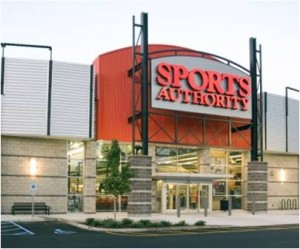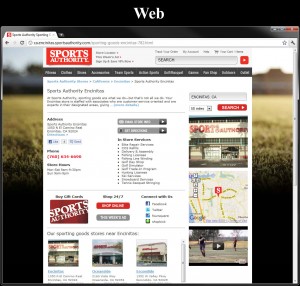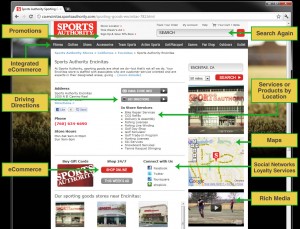Two Ways To Drive More Holiday Traffic & Conversions
Two ways brick ‘n mortar retailers can increase consumer engagement and conversions in time for the holidays are: (1) build a simple and robust mobile store locator, and (2) provide maximum coverage of the brand’s digital storefront in all the cities and neighborhoods for each location. Research by Brand Anywhere and Luth Research found retailers […]
Two ways brick ‘n mortar retailers can increase consumer engagement and conversions in time for the holidays are: (1) build a simple and robust mobile store locator, and (2) provide maximum coverage of the brand’s digital storefront in all the cities and neighborhoods for each location.
Research by Brand Anywhere and Luth Research found retailers can increase consumer engagement 85 percent by having a mobile-specific website.
Other key findings include:
- 51 percent of consumers are more likely to purchase from retailers that have mobile-specific websites
- Only 4.8 percent of U.S. retailers have mobile-specific websites
- A mere 22.8 percent of the top retailers (ranked by Alexa) have mobile-specific websites
Since consumers want to do business with stores that have mobile websites, and less than 5 percent of all U.S. retailers have optimized mobile websites, there’s a big gap between retailers providing mobile access and the large number of consumers who would like to shop mobile.
Building A Mobile Website & Mobile Store Locator
Consumers are making more purchase decisions based on information they get on their smartphones and tablets. Because consumers are asking for it, there is a window of opportunity for brands and retailers to embrace the mobile Web with enhanced mobile store locator software to gain a competitive advantage.
Research shows people want to know the following information when they shop:
- Coupons and special offers
- Product pricing
- Store location
Consumers are using their smartphones as a research tool to make purchase decisions, save money and comparison shop. They expect to see the same information and conversion tools on the Web and Mobile Web.
Managing Your Digital Storefront
If you’re a retailer, it behooves you to make your promotions, prices and locations available in a mobile environment for mobile devices, and on the Web for desktops, to have a better chance of engaging new and existing customers. Retailers can do this by managing their digital storefront.
Let’s drive by a few storefronts on Main Street USA… every physical store, dealership, franchise and branch office you walk or drive by displays their business hours on the front door, and there’s a sign identifying their brand and logo out in front of each storefront location.
When you walk in, you can easily find their business offerings, specials, sales, and discounts, all posted at eye-level in creative formats, arrangements and colors. The shelf-space is well organized by category; you might see Co-Op advertising, a circular flyer with local weekly specials for that particular store, or national magazine advertising deals that are updated and valid in every store location.
The physical storefront has a manager or GM responsible for all the details of operation, making sure the store and its employees are working efficiently to assist walk-in and call-in customers.
The construction of the physical storefront location is usually a cookie-cutter version of all the other locations. If you walk into a Sports Authority in Encinitas CA, chances are you will have a very similar experience at the Sports Authority in Boca Raton FL, Dearborn MI or Albany NY. However, the promotions, inventory, pricing, business hours, etc., may differ from one location to another.
The process of building and operating a physical storefront location or managing numerous dealership or franchise locations requires specialized, well-trained, experienced staff and personnel. We call ‘em brick ‘n clicks, a brand with multi-locations that has both a physical and online store presence.
It’s taken a while for brick ‘n clicks to make the transition online. The Web and Mobile Web side of the business also require the same specialized, well-trained, experienced staff and personnel to build, operate and manage the digital storefront software.
It is critical for Brands to understand that their new and existing customers online expect to see and experience all the same conversion tools they see offline.
A link to click to the shopping site from Web and Mobile Web location landing pages is a conversion tool and should be consistent across both Web and Mobile Web.
A comScore study found that 82 percent of local searchers follow up offline with an in-store visit, phone call or purchase, and of these, 61 percent made purchases.
Providing mobile recognition and the capability to search each individual business location page by IP, city or zip code will increase your walk-in traffic and offline sales. Users expect to see the address, click to phone, product descriptions and links to each location landing page.
A link to telephone and map directions is a conversion tool and should be consistent across both Web and Mobile Web. Customers will call you if it’s convenient to click and call. If you don’t provide accurate telephone numbers online for each business location, you will lose customers to competitors who have maximized their digital storefront data.
Customers want to find and drive to your location when it’s convenient to click to map directions from their mobile device, tablet or desktop.
Posting your rich media videos and social sharing buttons is a conversion tool and should be consistent across both Web and Mobile Web. Customers like to see consistency when they’re on a mobile device or laptop, and it’s very important to provide accurate information. Those who don’t will lose customers to competitors who have maximized their digital storefront data.
Allowing customers to redeem Print Coupons using QR codes converted from print, or Web to Mobile device, is another conversion tool. When a direct mail campaign coordinates with online marketing, customers will snap a picture and drive to your location to redeem their discount in a physical store location.
Additional conversion tools include Gift Cards, Loyalty Programs, Reviews and more − these are all conversion tools to be managed in your digital storefront, just as similar conversion tools are managed from your physical storefront.
In conclusion, when big retail brands maximize their conversion tools and create consistency across their brick ‘n mortar, digital storefront and mobile web presence, they will increase consumer engagement and conversions in time for the coming holiday shopping season.
This is the best way to drive conversions and crush the competition as the stats don’t lie; you’ll be ahead of over 75 percent of U. S. retailers.
Disclosure: I advise firms that provide and/or distribute digital storefront software.
Contributing authors are invited to create content for Search Engine Land and are chosen for their expertise and contribution to the search community. Our contributors work under the oversight of the editorial staff and contributions are checked for quality and relevance to our readers. The opinions they express are their own.
Related stories
New on Search Engine Land



